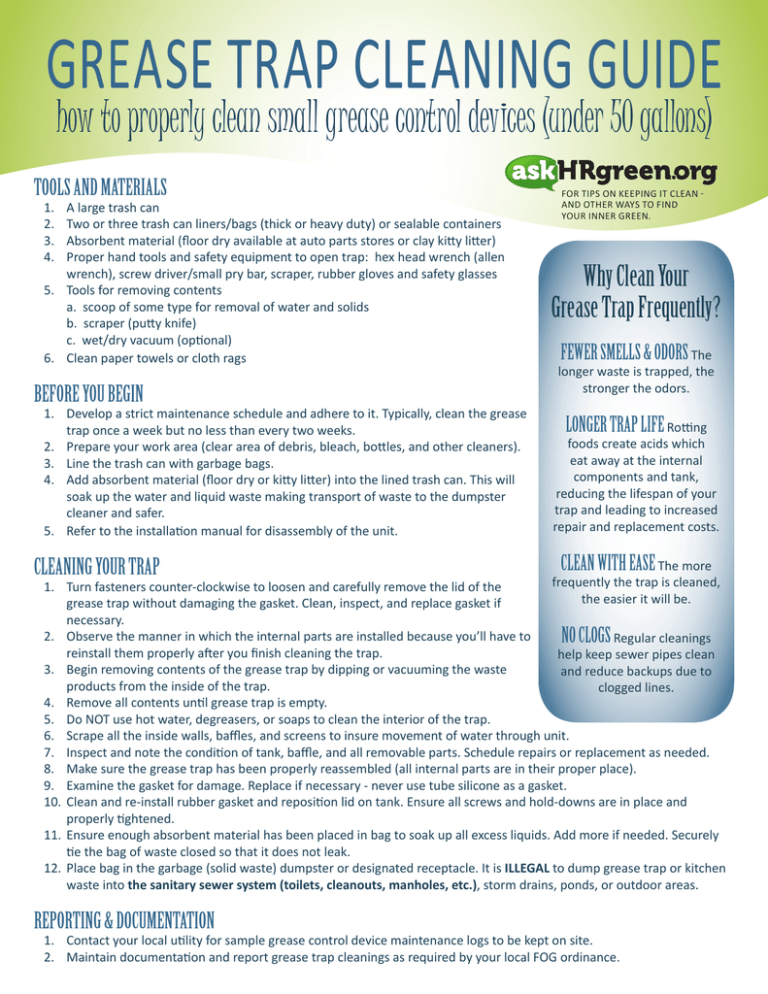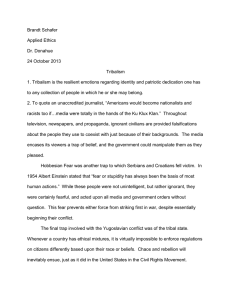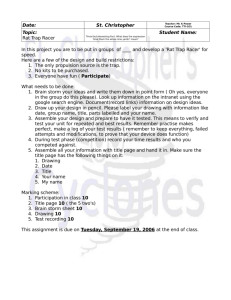GREASE TRAP CLEANING GUIDE
advertisement

GREASE TRAP CLEANING GUIDE how to properly clean small grease control devices (under 50 gallons) TOOLS AND MATERIALS 1. 2. 3. 4. A large trash can Two or three trash can liners/bags (thick or heavy duty) or sealable containers Absorbent material (floor dry available at auto parts stores or clay kitty litter) Proper hand tools and safety equipment to open trap: hex head wrench (allen wrench), screw driver/small pry bar, scraper, rubber gloves and safety glasses 5. Tools for removing contents a. scoop of some type for removal of water and solids b. scraper (putty knife) c. wet/dry vacuum (optional) 6. Clean paper towels or cloth rags BEFORE YOU BEGIN 1. Develop a strict maintenance schedule and adhere to it. Typically, clean the grease trap once a week but no less than every two weeks. 2. Prepare your work area (clear area of debris, bleach, bottles, and other cleaners). 3. Line the trash can with garbage bags. 4. Add absorbent material (floor dry or kitty litter) into the lined trash can. This will soak up the water and liquid waste making transport of waste to the dumpster cleaner and safer. 5. Refer to the installation manual for disassembly of the unit. CLEANING YOUR TRAP FOR TIPS ON KEEPING IT CLEAN AND OTHER WAYS TO FIND YOUR INNER GREEN. Why Clean Your Grease Trap Frequently? FEWER SMELLS & ODORS The longer waste is trapped, the stronger the odors. LONGER TRAP LIFE Rotting foods create acids which eat away at the internal components and tank, reducing the lifespan of your trap and leading to increased repair and replacement costs. CLEAN WITH EASE The more frequently the trap is cleaned, the easier it will be. 1. Turn fasteners counter-clockwise to loosen and carefully remove the lid of the grease trap without damaging the gasket. Clean, inspect, and replace gasket if necessary. 2. Observe the manner in which the internal parts are installed because you’ll have to NO CLOGS Regular cleanings reinstall them properly after you finish cleaning the trap. help keep sewer pipes clean 3. Begin removing contents of the grease trap by dipping or vacuuming the waste and reduce backups due to products from the inside of the trap. clogged lines. 4. Remove all contents until grease trap is empty. 5. Do NOT use hot water, degreasers, or soaps to clean the interior of the trap. 6. Scrape all the inside walls, baffles, and screens to insure movement of water through unit. 7. Inspect and note the condition of tank, baffle, and all removable parts. Schedule repairs or replacement as needed. 8. Make sure the grease trap has been properly reassembled (all internal parts are in their proper place). 9. Examine the gasket for damage. Replace if necessary - never use tube silicone as a gasket. 10. Clean and re-install rubber gasket and reposition lid on tank. Ensure all screws and hold-downs are in place and properly tightened. 11. Ensure enough absorbent material has been placed in bag to soak up all excess liquids. Add more if needed. Securely tie the bag of waste closed so that it does not leak. 12. Place bag in the garbage (solid waste) dumpster or designated receptacle. It is ILLEGAL to dump grease trap or kitchen waste into the sanitary sewer system (toilets, cleanouts, manholes, etc.), storm drains, ponds, or outdoor areas. REPORTING & DOCUMENTATION 1. Contact your local utility for sample grease control device maintenance logs to be kept on site. 2. Maintain documentation and report grease trap cleanings as required by your local FOG ordinance.





